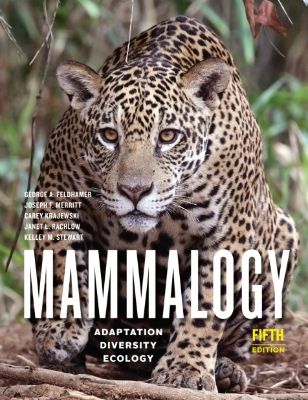Mammalogy: Adaptation, Diversity, Ecology

Lýsing:
There are more than 6,400 species in the class Mammalia, including the blue whale—the largest animal that has ever lived—and the pygmy shrew, which weighs little more than a dime. Such diversity among mammals has allowed them to play critical roles in every ecosystem, whether marine, freshwater, alpine, tundra, forest, or desert. Reflecting the expertise and perspective of five leading mammalogists, the fifth edition of Mammalogy: Adaptation, Diversity, Ecology significantly updates taxonomy, adds a new introductory chapter on the science of mammalogy, and highlights several recently described species.
To enhance its appeal to students, textual material has been reduced, consolidated, and streamlined without sacrificing breadth or depth of coverage. The fifth edition includes • for the first time, stunning color photographs throughout • chapters rearranged and grouped to best reflect phylogenetic relationships, with updated numbers of genera and species for each family • updated mammalian structural and functional adaptations, as well as ordinal fossil histories • recent advances in mammalian phylogeny, biogeography, social behavior, and ecology, with 12 new or revised cladograms reflecting current research findings • new breakout boxes on novel or unique aspects of mammals • new work on female post-copulatory mate choice, cooperative behaviors, group defense, and the role of the vomeronasal system • discussions of the current implications of climate change and other anthropogenic factors for mammals Maintaining the accessible, readable style for which Feldhamer and his coauthors are well known, this new edition of Mammalogy is the authoritative textbook on this amazingly diverse class of vertebrates.
Annað
- Höfundar: George A. Feldhamer, Joseph F. Merritt, Carey Krajewski, Janet L. Rachlow, Kelley M. Stewart
- Útgáfa:5
- Útgáfudagur: 2020-03-24
- Engar takmarkanir á útprentun
- Engar takmarkanir afritun
- Format:Page Fidelity
- ISBN 13: 9781421436531
- Print ISBN: 9781421436524
- ISBN 10: 1421436531
Efnisyfirlit
- Contents
- Preface
- Part 1. Introduction
- Chapter 1. The Science of Mammalogy
- Mammals
- Why Study Mammals?
- History of Mammalogy
- Modern Mammalogy as an Interdisciplinary Science
- Resources for Mammalogists
- Summary
- Suggested Readings
- Discussion Questions
- Chapter 1. The Science of Mammalogy
- Chapter 2. Methods for Studying Mammals
- Field Methods
- Laboratory and Museum Methods
- Systematic Methods
- Summary
- Suggested Readings
- Discussion Questions
- Relationships and Classification of Living Mammalian Orders
- Timing of the Mammalian Radiations
- Summary
- Suggested Readings
- Discussion Questions
- Synapsid Lineage
- Origin of Mammals: Monophyletic or Polyphyletic?
- The First Mammals
- Cenozoic Mammals and Mammalian Radiation
- Interrelationship of Characteristics and Increased Metabolism
- Summary of Anatomical Trends in Organization from Mammal-Like Amniotes to Mammals
- Characteristics of Modern Mammals
- Dentition
- Summary
- Suggested Readings
- Discussion Questions
- Global Provincialism of Mammalian Distributions
- Historical Biogeography
- Ecological Biogeography
- Summary
- Suggested Readings
- Discussion Questions
- Chapter 6. Integument, Support, and Movement
- Integument
- Basic Skeletal Patterns
- Muscles
- Modes of Locomotion
- Summary
- Suggested Readings
- Discussion Questions
- Foods and Feeding
- Foraging Strategies
- Summary
- Suggested Readings
- Discussion Questions
- Heat Transfer between a Mammal and the Environment
- Temperature Regulation
- Adaptations to Cold
- Adaptations to Heat
- Summary
- Suggested Readings
- Discussion Questions
- The Reproductive Systems
- Gestation
- Reproductive Variations
- Parturition
- Lactation
- Summary
- Suggested Readings
- Discussion Questions
- Chapter 10. Orders: Monotremata and Marsupials
- Monotremata
- Marsupials
- Summary
- Suggested Readings
- Discussion Questions
- Macroscelidea
- Afrosoricida
- Tubulidentata
- Summary
- Suggested Readings
- Discussion Questions
- Proboscidea
- Hyracoidea
- Sirenia
- Summary
- Suggested Readings
- Discussion Questions
- Superorder Xenarthra
- Summary
- Suggested Readings
- Discussion Questions
- Scandentia
- Dermoptera
- Summary
- Suggested Readings
- Discussion Questions
- Ordinal and Morphological Characteristics
- Fossil History
- Economics and Conservation
- Suborder Strepsirrhini
- Suborder Haplorrhini
- Summary
- Suggested Readings
- Discussion Questions
- Rodentia
- Lagomorpha
- Summary
- Suggested Readings
- Discussion Questions
- Order Eulipotyphla
- Summary
- Suggested Readings
- Discussion Questions
- Order Carnivora
- Order Pholidota
- Summary
- Suggested Readings
- Discussion Questions
- Perissodactyla
- Cetartiodactyla
- Summary
- Suggested Readings
- Discussion Questions
- Morphology
- Fossil History
- Economics and Conservation
- Parvorders and Families
- Summary
- Suggested Readings
- Discussion Questions
- Suborders and Superfamilies
- Morphology
- Fossil History
- Economics and Conservation
- Suborder Yinpterochiroptera
- Suborder Yangochiroptera
- Summary
- Suggested Readings
- Discussion Questions
- Chapter 22. Sexual Selection, Parental Care, and Mating Systems
- Anisogamy and Competition for Mates
- Sexual Selection
- Parental Investment
- Parent-Offspring Conflict
- Mating Systems
- Summary
- Suggested Readings
- Discussion Questions
- The Sociality Spectrum
- Why Mammals Live in Groups
- How Social Behavior Evolves
- Communication
- Summary
- Suggested Readings
- Discussion Questions
- Home Range
- Territory
- Habitat and Selection of Resources
- Dispersal
- Migration
- Summary
- Suggested Readings
- Discussion Questions
- Population Processes
- Population Growth and Equilibrium
- Life History
- Cycles
- Summary
- Suggested Readings
- Discussion Questions
- Ecological Niche
- Species Interactions and Community Structure
- Community Function
- Community Patterns
- Summary
- Suggested Readings
- Discussion Questions
- Chapter 27. Parasites and Zoonotic Diseases
- Mammalian Parasites and Diseases
- Vector-Borne Zoonoses
- Nonvector Zoonoses
- Summary
- Suggested Readings
- Discussion Questions
- Nature of the Problem
- Approaches to Solutions
- Case Studies
- Summary
- Suggested Readings
- Discussion Questions
- A
- B
- C
- D
- E
- F
- G
- H
- I
- J
- K
- L
- M
- N
- O
- P
- Q
- R
- S
- T
- U
- V
- W
- X
- Y
- Z
UM RAFBÆKUR Á HEIMKAUP.IS
Bókahillan þín er þitt svæði og þar eru bækurnar þínar geymdar. Þú kemst í bókahilluna þína hvar og hvenær sem er í tölvu eða snjalltæki. Einfalt og þægilegt!Rafbók til eignar
Rafbók til eignar þarf að hlaða niður á þau tæki sem þú vilt nota innan eins árs frá því bókin er keypt.
Þú kemst í bækurnar hvar sem er
Þú getur nálgast allar raf(skóla)bækurnar þínar á einu augabragði, hvar og hvenær sem er í bókahillunni þinni. Engin taska, enginn kyndill og ekkert vesen (hvað þá yfirvigt).
Auðvelt að fletta og leita
Þú getur flakkað milli síðna og kafla eins og þér hentar best og farið beint í ákveðna kafla úr efnisyfirlitinu. Í leitinni finnur þú orð, kafla eða síður í einum smelli.
Glósur og yfirstrikanir
Þú getur auðkennt textabrot með mismunandi litum og skrifað glósur að vild í rafbókina. Þú getur jafnvel séð glósur og yfirstrikanir hjá bekkjarsystkinum og kennara ef þeir leyfa það. Allt á einum stað.
Hvað viltu sjá? / Þú ræður hvernig síðan lítur út
Þú lagar síðuna að þínum þörfum. Stækkaðu eða minnkaðu myndir og texta með multi-level zoom til að sjá síðuna eins og þér hentar best í þínu námi.
Fleiri góðir kostir
- Þú getur prentað síður úr bókinni (innan þeirra marka sem útgefandinn setur)
- Möguleiki á tengingu við annað stafrænt og gagnvirkt efni, svo sem myndbönd eða spurningar úr efninu
- Auðvelt að afrita og líma efni/texta fyrir t.d. heimaverkefni eða ritgerðir
- Styður tækni sem hjálpar nemendum með sjón- eða heyrnarskerðingu
- Gerð : 208
- Höfundur : 18010
- Útgáfuár : 2020
- Leyfi : 379


